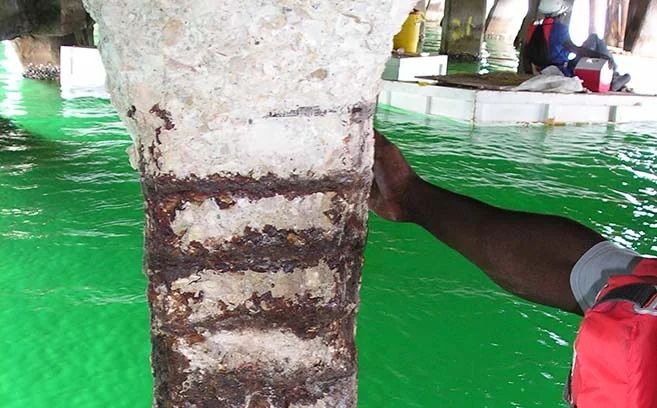Reinforcing steel found completely corroded form combination of atmospheric and chloride attack.
Concrete, a complex composite material, has low strength when loaded in tension.
To improve its tensile mechanical properties, it has become common practice to reinforce concrete with steel. Accordingly, concrete structures such as piers, bridges, and dam faces, contain reinforcing steel (commonly referred to as rebar). The primary causes of deterioration of steel-reinforced concrete structures are the chemical reactions that attack the aggregate/cement matrix and the resultant corrosion damage to the reinforcing steel embedded within the concrete.
The corrosion of the reinforcing steel can be explained through an examination of the chemical reactions involved. The presence of a significant amount of calcium hydroxide and relatively small amounts of alkali elements (such as sodium and potassium) gives concrete a very high alkalinity. When the structure is in its infancy, this high alkalinity results in the transformation of a surface layer of the embedded steel to a tightly adhering film. As long as this film is not disturbed, it will keep the steel passive and protected from corrosion.
When a concrete structure is repeatedly exposed to salt spray or submerged in saltwater, however, chloride ions slowly penetrate the concrete. The chloride ions will eventually reach the steel, where they accumulate to the point where the protective film is destroyed and the steel begins to corrode. This corrosion is facilitated by the presence of both oxygen and moisture at the steel-concrete interface.
Standard marine concrete mix designs utilizing type II or type V cement absorb moisture when placed in water. In higher latitudes, which experience regular freeze/thaw cycling (thermal cycling), the addition of even small amounts of water into the concrete surface matrix creates a destructive process that slowly erodes the exposed surface. This effect is most prevalent at the air/water interface, easily identified by hour-glass-shaped deterioration.
In combination with alkali reactions and chloride/oxidation corrosion of reinforcing steel, the marine environment is a very harsh place for concrete. Many additives are available to enhance concrete mix design and significantly reduce these effects in new construction. Once damage has been done, however, concrete requires remediation. Fortunately, restoration materials – correctly selected and installed –can add new life to structures and mitigate further deterioration for decades.
To learn about methods of combating this issue, see Countering Corrosion.
Do you think you have a concrete corrosion problem? See how we can help.
